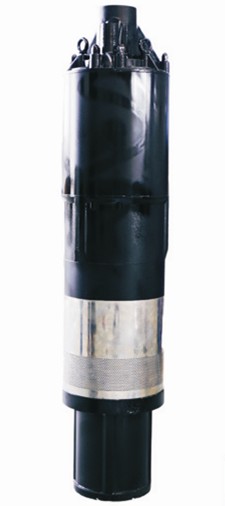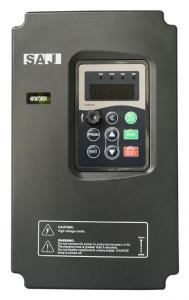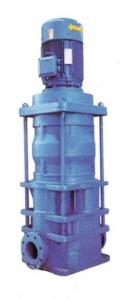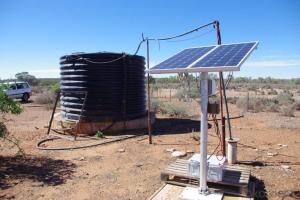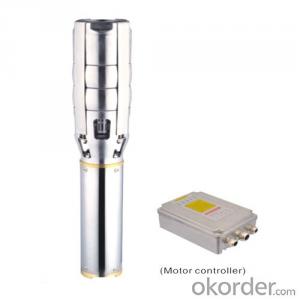Ebay Solar Pump 3ds-10-50
- Loading Port:
- China Main Port
- Payment Terms:
- TT OR LC
- Min Order Qty:
- -
- Supply Capability:
- 300 sets /month
OKorder Service Pledge
OKorder Financial Service
You Might Also Like
Product description:
Product: Solar water pump
Model:3DS-10
 Appilication:
Appilication:
submersible pump
for deep well or water tank or pond or small lake
for irrigation of a farm cover around 5000 m2
For all kinds of irrigation: flood /sprinkling/ drip
Product specification:
flow rate:8000 liter/ hour, 64m3/day.
lift: 10m-50m
pump diameter: 238mm
well diameter more than 250mm
with BLDC motor, motor power:2000W
but only need solar power:960W, our pump can save more than 50% solar panel power.
Material:
Pump inside: stainless steel and wearable nylon,it enables our solar pump to have 10 years sevice life.
Motor length:30cm,80% shorter than other motors. So that you can pump 80% more water by our solar pump.
Certification:
3 International patent
ISO9001
CE
Warranty:2 years
- Q: Can a solar pump be used for water supply in disaster-stricken areas?
- Indeed, in disaster-stricken areas, a solar pump has the capability to cater to water supply needs. These pumps are a dependable and sustainable alternative for ensuring access to water in areas where conventional power sources may be disrupted or unavailable. By harnessing solar energy, these pumps operate without the need for fuel or electricity, making them cost-effective and environmentally friendly. In areas struck by disasters, the availability of clean water is often an urgent requirement. Solar pumps can be utilized to extract water from wells, boreholes, or other water sources, and subsequently distribute it to communities for various purposes such as drinking, irrigation, etc. Their installation and operation are hassle-free, demanding minimal maintenance and devoid of ongoing fuel expenses. Moreover, solar pumps can be equipped with storage systems, enabling the collection and preservation of water during daylight hours for later use during unfavorable conditions, such as at night or on overcast days. This guarantees an uninterrupted and dependable water supply, even in challenging circumstances. Furthermore, solar pumps can be seamlessly integrated with water purification systems, thus providing clean and safe drinking water in disaster-stricken areas where water sources may be contaminated. The amalgamation of solar pumping and water purification can significantly enhance the overall water supply situation and contribute to the prevention of waterborne diseases. All in all, solar pumps present a practical and sustainable solution for water supply in disaster-stricken areas. They furnish a reliable water source without relying on traditional power sources, making them an ideal choice for ensuring access to clean water during emergency situations.
- Q: Can a solar pump be used for water supply in remote islands?
- Yes, a solar pump can be used for water supply in remote islands. Solar-powered pumps are an excellent solution for remote locations where access to electricity may be limited or nonexistent. They harness energy from the sun to power the pump, drawing water from a well or other water source and supplying it to the desired location. This makes them a sustainable and cost-effective option for providing water supply in remote islands without relying on traditional power grids.
- Q: Can a solar pump be used for hydroponic farming systems?
- Certainly, hydroponic farming systems can make effective use of a solar pump. In hydroponic farming, plants are cultivated without the use of soil, typically relying on water as the medium for growth. The introduction of a solar pump can facilitate the necessary circulation of water and delivery of nutrients to the plants within the hydroponic system. Given that solar pumps operate solely on sunlight, they represent a sustainable and economical choice for powering hydroponic setups. By harnessing solar energy, farmers can reduce their dependence on conventional energy sources, thereby reducing their carbon emissions. The seamless integration of solar pumps into hydroponic systems ensures a dependable and eco-friendly solution for managing water and nutrients.
- Q: How does the performance of a solar pump vary with different solar panel efficiencies?
- The solar pump's performance can vary greatly depending on the efficiency of the solar panels used. Solar pumps rely on solar panels to convert sunlight into electrical energy, which is then used to power the pump. The efficiency of a solar panel refers to its ability to convert sunlight into usable electricity. When higher efficiency solar panels are used, they are able to convert more sunlight into electricity, resulting in increased power output. This means that a solar pump connected to highly efficient solar panels will have a higher energy output, leading to a higher flow rate and increased water pumping capacity. Conversely, solar panels with lower efficiencies are not as effective at converting sunlight into electricity. This leads to lower power output, which can negatively impact the performance of the solar pump. A pump connected to less efficient solar panels may have lower flow rates and reduced pumping capacity, especially during times when sunlight intensity is lower or daylight hours are shorter. In addition, the performance of a solar pump is influenced by other factors such as the pump's design, the type of motor it utilizes, and the overall system configuration. However, the efficiency of the solar panels remains a critical factor in determining the overall performance of the solar pump. Therefore, it is crucial to consider the efficiency of the solar panels when choosing a solar pump system. Higher efficiency solar panels generally result in better performance and more dependable water pumping capabilities, particularly in areas with limited sunlight resources.
- Q: How do solar pumps handle water with high fluoride or chemical content?
- Solar pumps can handle water with high fluoride or chemical content in a similar way as traditional pumps. The primary function of solar pumps is to circulate and transfer water, regardless of its chemical composition. However, it's important to note that the quality of the water being pumped may have an impact on the longevity and efficiency of the pump. In cases where high fluoride or chemical content is a concern, pre-treatment methods such as filtration or chemical treatment may be necessary to ensure the pump's optimal performance and longevity.
- Q: Can a solar pump be used for water supply in a refugee camp?
- Yes, a solar pump can be used for water supply in a refugee camp. Solar pumps are a sustainable and cost-effective solution for providing clean and reliable water in areas without access to electricity. They can draw water from wells, rivers, or other water sources and provide a consistent supply of water for drinking, cooking, and sanitation purposes in a refugee camp. Additionally, solar pumps have low maintenance requirements and are environmentally friendly, making them an ideal choice for water supply in such settings.
- Q: Can solar pumps be used for water supply in recreational facilities or parks?
- Yes, solar pumps can be effectively used for water supply in recreational facilities or parks. Solar pumps are a sustainable and environmentally friendly solution that utilize energy from the sun to power water pumping systems. They can efficiently provide water for various purposes such as irrigation, fountains, or even drinking water supply in these recreational areas. Solar pumps offer a cost-effective and reliable alternative to traditional electricity-dependent pumps, making them an ideal choice for water supply in parks and recreational facilities.
- Q: What is the maximum lift height of a solar pump?
- The specific model and design of a solar pump can cause variations in its maximum lift height. Generally, solar pumps have the capability to raise water to heights that span from a few meters to several hundred meters. Factors like the power of the solar panel system, the pump's efficiency, and the dimensions of the water pipe determine the maximum lift height. To ascertain the maximum lift height for a specific solar pump model, it is crucial to refer to the manufacturer's specifications and recommendations.
- Q: How does the performance of a solar pump vary with different sunlight intensities?
- The performance of a solar pump varies with different sunlight intensities. Solar pumps are designed to operate using solar energy, which means they are directly affected by the amount of sunlight available. When sunlight intensity is high, meaning there is abundant sunshine, the solar pump will have a higher performance. This is because the solar panels will receive more sunlight and produce more electricity, which in turn powers the pump to operate at its maximum capacity. The higher the sunlight intensity, the more energy is generated and the more efficiently the pump can function. On the other hand, when sunlight intensity is low, such as during cloudy or overcast days, the performance of the solar pump will be reduced. This is because there is less sunlight available for the solar panels to convert into electricity. As a result, the pump may operate at a slower speed or even stop working altogether if the sunlight intensity is too low. It is important to note that the performance of a solar pump is not solely dependent on sunlight intensity. Other factors like the efficiency of the solar panels, the size of the pump, and the capacity of the battery (if present) also play a role in determining its overall performance. However, sunlight intensity remains a critical factor as it directly affects the amount of energy that can be harnessed from the sun, thereby impacting the efficiency and output of the solar pump.
- Q: Can a solar pump be used in conjunction with a battery backup system?
- Yes, a solar pump can be used in conjunction with a battery backup system. The solar panels will generate power during the day, which can be used to directly power the pump or charge the batteries. The battery backup system will store excess power generated by the solar panels, allowing the pump to continue operating during periods of low sunlight or at night.
Send your message to us
Ebay Solar Pump 3ds-10-50
- Loading Port:
- China Main Port
- Payment Terms:
- TT OR LC
- Min Order Qty:
- -
- Supply Capability:
- 300 sets /month
OKorder Service Pledge
OKorder Financial Service
Similar products
Hot products
Hot Searches
Related keywords

